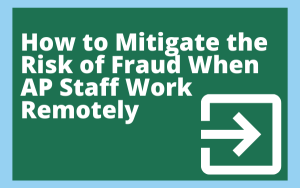How to Mitigate the Risk of Fraud When AP Staff Work Remotely

How to Mitigate the Risk of Fraud When AP Staff Work Remotely
If it feels like the shift to remote working has created new risks for your AP team, you are not alone.
Twenty-five percent of AP leaders surveyed by the Institute of Finance and Management (IOFM) say that the increased risk of payment fraud is the single biggest challenge created by remote working.
It’s been hard for most AP departments to adapt established policies and procedures for processing invoices and paying suppliers to a remote work environment. While some AP departments had business continuity plans in place for short-term disruptions to their operations, few had given serious consideration to how their operations would function long-term in a remote environment.
Manual, paper-based processes weren’t designed with remote workers in mind. Businesses risk big delays in paying suppliers because of the limitations of their manual AP processes. As a result, businesses of all sizes are relying heavily on manual workarounds as their staff work remotely:
- Manual routing of invoices via unsecure email
- Manual file uploads
- Manually generated reports
- Manual inputs to payment portals
While these workarounds may get suppliers paid, they also expose businesses to additional risks.
Not surprisingly, law enforcement agencies are warning of increased risk of payment fraud. Forty percent of AP leaders surveyed by IOFM say their department was the target of multiple fraud attacks in 2021. Another 33 percent of AP departments were targeted once by fraudsters in 2021.
4 ways AP Automation Mitigates Risk
With no telling when, or if, employees will return to the office full-time, AP departments must find ways to improve control, tracking, and visibility over their processes, no matter where staff work.
Here are four ways that AP automation helps businesses mitigate the risk of payment fraud:
- Digital approval processes. Many businesses are relying on emails to route invoices for approval when staff work remotely. It’s no coincidence that phishing schemes, Business Email Compromise (BEC) attacks, and account takeovers are soaring. AP automation solutions provide a more secure option. Digital workflows prevent emails from inadvertently being misrouted to the wrong individual. And, unlike email invoice routing, AP automation solutions restrict system access by user and role, enforce separation of duties, ensure chain of custody, log all actions taken on an invoice, provide AP staff with visibility into the status of invoices, and prevent invoices and data from being deleted ahead of retention schedules.
- Straight-through processing. Manual processes create opportunities for bad actors. AP automation solution reduce the potential for fraud by facilitating the straight-through posting of invoices to any accounting software or ERP application. Invoices are automatically gathered from email boxes, FTP landing sites, and supplier portals, invoice data is extracted and validated, and matched invoices are posted to the system of record, without the need for human operator intervention. Only unmatched invoices or invoices requiring approval (such as high-dollar invoices, invoices from strategic suppliers, or invoices without a purchase order) are digitally routed for approval. Highly automated AP departments post most of the invoices they receive without anyone having to touch them – mitigating potential risks.
- Real-time visibility. AP departments cannot address risks that they cannot see. AP automation solutions create an environment where staff always know where things stand and what actions have been taken. Graphical dashboards show the real-time status of invoices. Drill-capabilities enable staff to quickly access invoice details. Audit logs provide visibility into every action taken on an invoice. Seamless integration with accounting software or an ERP application makes it a snap to validate vendor information. Artificial intelligence (AI) analyzes the patterns in historical data to identify potentially fraudulent invoices.
- Electronic payments. Paper check payments are responsible for 10 times as much fraud as electronic transactions such as Automated Clearing House (ACH), Real-Time Payment (RTP), and virtual cards. Unlike paper checks, electronic payments cannot be intercepted in the mail and whitewashed for deposit into a fraudster’s account. Electronic payments can be tracked each step along the way. What’s more, real-time reconciliation of electronic payments means a payer will know of issues fast. Banking account details for electronic payments also can be stored with a trusted third party. And virtual cards can be set for a specific vendor, amount and date, and the recipient never receives the full 16-digit card number. Because they are plastic-less, virtual cards also cannot fall into the wrong hands.
This is where a certified JDE consulting expert can help with this automation.
Remote work is the new normal.
Businesses cannot afford the vulnerabilities created by trying to adapt manual, paper-based invoice approval and supplier payment processes to a remote work environment. AP automation provides the control, tracking, and visibility that AP departments need, no matter where their staff works.
